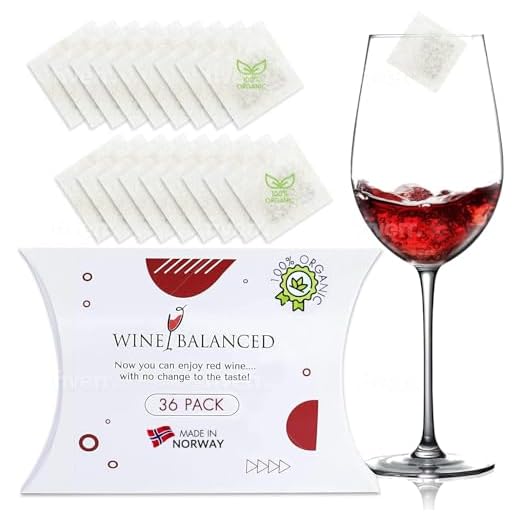



Yes, nearly every bottle of crimson beverage includes some level of these compounds as a preservative. This is a common practice in the winemaking process, aimed at preventing oxidation and maintaining flavor integrity.
Those with sensitivities or allergies should be aware that even minimal amounts can trigger reactions. If you’re seeking options with reduced levels, look for labels that specifically state “no added preservatives” or “organic.” These selections may align better with your dietary considerations.
For enthusiasts, understanding the presence of these substances can enhance your tasting experience. It’s worthwhile to explore various producers, as some may prioritize natural methods that limit their usage. Engaging with knowledgeable retailers or sommeliers can further guide you in discovering bottles tailored to your preferences.
Do All Red Wines Have Sulfites?
Yes, nearly every bottle of dark-hued grape beverage will have some level of these compounds. While many producers add these preservatives to enhance stability and prolong shelf life, even those that fall under the organic category may still contain naturally occurring forms, albeit in lesser amounts.
Understanding the Role of Sulfites
These compounds act as antioxidants, helping to prevent oxidation and spoilage. This is particularly important for darker varietals, which tend to be more susceptible to these issues. If you’re seeking options with minimal additives, look for labels that specify “sulfite-free” or “no added sulfites.” However, it’s crucial to understand that naturally occurring levels may still be present.
Consumer Awareness and Labeling
In regions like the United States and the European Union, regulations mandate that any bottle containing greater than ten parts per million must indicate this on the label. If you’re sensitive to these substances, carefully read the packaging and consider exploring lesser-known producers who prioritize minimal intervention in their vinification process.
Ultimately, if you wish to avoid these substances entirely, focusing on small-batch, organic producers may yield the best results. Experiment with different selections to find what suits your palate while aligning with your preferences regarding additives.
Understanding Sulfites in Wine Production
During fermentation, winemakers often introduce preservatives to maintain the quality and stability of the beverage. One common additive is sulfur dioxide, which serves multiple roles, including preventing oxidation and controlling unwanted microbial activity. This compound can occur naturally in small amounts during fermentation, but many producers add it for consistency and longevity.
Most producers aim for a final concentration that balances preservation with the wine’s character. The legal maximum levels vary by region, with some places allowing higher amounts than others. A typical range may be between 30 to 50 parts per million, depending on the style and intended aging potential.
For those sensitive to these additives, it’s advisable to check labels carefully. Some brands specifically indicate low levels or no addition at all. Organic and natural varieties often provide alternatives, as these may utilize minimal intervention techniques, although they might still have trace amounts due to natural fermentation processes.
In my experience, understanding the role of these compounds can greatly enhance appreciation for different styles and flavors. Exploring options with lower levels may lead to discovering unique and expressive profiles that align with your palate preferences.
Natural vs. Added Sulfites in Red Wines
When selecting a bottle, it’s vital to recognize the distinction between naturally occurring and intentionally added compounds. Naturally occurring compounds form during fermentation, while additions are made to enhance stability and longevity.
Here’s a breakdown to help you understand the differences:
- Naturally Occurring: Fermentation leads to the production of small amounts of these compounds. Grapes themselves generate a minimal level during the winemaking process.
- Intentionally Added: Winemakers often introduce these additives to prevent oxidation and spoilage, ensuring a more consistent product.
Choosing a bottle that specifies its treatment can enhance your tasting experience. Look for labels that indicate a low or no addition of these compounds if you prefer a more organic approach.
Some producers emphasize their minimal intervention methods, which may appeal to those seeking authenticity in flavor. However, keep in mind that these practices can lead to variability in taste and quality.
For those sensitive or allergic to these compounds, it’s advisable to consult producers directly or seek out wines specifically labeled as having lower levels. Always check the back label for detailed information regarding the wine’s composition.
Ultimately, understanding the difference between these two forms helps in making informed decisions, enhancing both your enjoyment and appreciation of your chosen varietals.
Identifying Sulfite-Free Options
To find selections without added preservatives, look for labels stating “no sulfites added” or “sulfite-free.” These products usually originate from organic vineyards or natural winemakers who prioritize minimal intervention.
Research Producers
Investigate wineries known for their dedication to producing without synthetic additives. Many small or family-owned vineyards focus on organic or biodynamic practices, ensuring minimal chemical use during production. These producers often share their methods online or in their tasting rooms.
Explore Specific Regions
Certain regions are renowned for cultivating grapes naturally with fewer interventions. Areas like the Loire Valley in France or some parts of California often have options that align with this philosophy. Seek out varietals from these regions, and don’t hesitate to ask local wine shops for recommendations.
Lastly, taste and trust your palate. Sampling various selections will help you identify those that suit your preferences while aligning with your desire for fewer additives.
The Role of Sulfites in Wine Preservation
To maintain freshness and stability, winemakers often utilize sulfur dioxide. This compound plays a significant role in preventing oxidation and spoilage, ensuring the longevity of the beverage.
Here are the primary functions of sulfur dioxide in wine preservation:
- Antioxidant Properties: It effectively neutralizes free radicals, which can lead to undesirable changes in flavor and color over time.
- Antimicrobial Action: By inhibiting the growth of unwanted bacteria and wild yeasts, it helps preserve the intended characteristics of the product.
- Color Stabilization: The presence of sulfur dioxide helps to maintain the vivid hues of the liquid, preventing browning and loss of visual appeal.
Understanding the balance between natural and added forms is essential. While some varietals may develop sulfites naturally during fermentation, others may require additional doses for optimal preservation. This distinction is crucial for consumers seeking specific profiles.
For those interested in enjoying their experience without sulfites, it’s vital to look for options labeled as ‘sulfite-free.’ However, be aware that these selections often have a shorter shelf life and may require more careful handling to maintain quality.
In summary, sulfur dioxide is a key player in the preservation of beverages, contributing to both flavor and longevity. When exploring choices, consider how this compound influences your preferences and the overall tasting experience.
Health Implications of Sulfites for Consumers
Individuals sensitive to certain compounds may experience adverse reactions after consuming products with added preservatives. Symptoms can include headaches, hives, and digestive issues. For those with asthma, exposure to elevated levels of these compounds may trigger severe respiratory problems. It is advisable for consumers with known sensitivities to read labels carefully and choose options marked as “no added preservatives” to minimize health risks.
The FDA mandates that any product containing more than 10 parts per million of these compounds must declare it on the label. This requirement helps consumers make informed choices regarding their consumption. For individuals who are uncertain about their sensitivity, it may be beneficial to consult with a healthcare provider for personalized advice.
Maintaining a balanced approach to consumption is key. Moderate intake of beverages with low levels of these compounds is generally considered safe for the majority of the population. However, it’s prudent to monitor one’s own body reactions and adjust consumption accordingly.
| Symptoms of Sensitivity | Recommendations |
|---|---|
| Headaches | Consider low-preservative options |
| Hives | Consult with a healthcare provider |
| Digestive Issues | Track food and drink for triggers |
| Respiratory Problems | Avoid high-preservative products |
People who enjoy a variety of beverages should stay informed about different options available in the market. Exploring selections labeled as organic or natural may also provide alternatives that align with personal health preferences.
Labeling Regulations for Sulfites in Wines
Wines featuring added preservatives must adhere to strict labeling requirements. In the United States, any bottle containing more than 10 parts per million of sulfites must clearly state “Contains Sulfites” on the label. This regulation aims to inform consumers who may have sensitivities or allergies to these compounds.
European Union regulations are similar, requiring a specific mention of sulfites in the ingredients list for products exceeding the same threshold. This ensures transparency and allows customers to make informed choices regarding their purchases.
Different countries may have varying thresholds and requirements, so it’s crucial to familiarize yourself with local regulations when exploring international selections. The labeling practices not only promote consumer safety but also enhance the overall trust in the wine industry.
For anyone looking to maintain outdoor spaces, using a pressure washer for cleaning decks can be an excellent way to keep your environment pristine, just as understanding wine labeling helps maintain clarity in wine choices.
Alternatives to Sulfites in Winemaking
Utilizing alternatives to traditional preservatives can enhance the quality of your favorite beverages while catering to specific dietary preferences. One effective method is the use of ascorbic acid, or vitamin C, which acts as a natural antioxidant. This compound helps preserve freshness and color, making it a popular choice among producers looking to minimize chemical additives.
Another option is the incorporation of natural extracts from plants, such as rosemary or green tea. These botanicals have demonstrated antioxidant properties, supporting the stability of the beverage without introducing synthetic compounds. Their unique flavors can also contribute to the overall profile of the drink.
Microbial Management Techniques
Employing techniques like controlled fermentation can significantly reduce the need for chemical interventions. By managing yeast strains and fermentation temperatures, winemakers can create an environment that minimizes spoilage and oxidation. Additionally, using sterile filtration before bottling helps ensure that the final product remains free from undesirable microorganisms.
Innovative Packaging Solutions
Utilizing advanced packaging technologies, such as vacuum sealing or inert gas flushing, can further protect the contents from oxidation. These methods create a barrier against air, preserving the intended flavors and aromas without relying solely on preservatives. This approach not only extends shelf life but also maintains the integrity of the drink for consumers.
FAQ:
Do all red wines have sulfites?
No, not all red wines contain sulfites. While the majority of commercial red wines do include sulfites as a preservative, there are some wines labeled as “sulfite-free.” These wines typically use alternative preservation methods, but it’s important to note that they may still contain trace amounts of sulfites due to natural fermentation processes.
Why are sulfites added to red wine?
Sulfites are added to red wine primarily to prevent oxidation and preserve freshness. They also help inhibit the growth of unwanted bacteria and wild yeasts during fermentation. This preservation process allows the wine to maintain its intended flavor and aroma profile over time, making sulfites a common addition in winemaking.
Can people be allergic to sulfites in red wine?
Yes, some individuals can have a sensitivity or allergy to sulfites. Symptoms may include headaches, hives, or respiratory issues. However, true sulfite allergies are rare, and most people can consume sulfite-containing foods and beverages without any adverse reactions. If you suspect a sulfite sensitivity, it’s best to consult a healthcare professional.
How can I find sulfite-free red wines?
To find sulfite-free red wines, look for wines specifically labeled as “sulfite-free” or “no added sulfites.” These wines are often produced by smaller wineries that use organic or natural winemaking practices. It’s also helpful to check with local wine shops or online retailers that specialize in natural wines, as they may have more options available.









